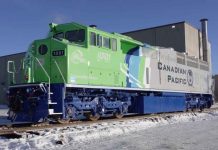
THUNDER BAY – It is a tale of visionary enthusiasm, determined effort, and of course hard work. Mooresville North Carolina through its Chamber of Commerce has been one of the world leaders in advocating and promoting hydrogen-powered passenger rail, which has become known as Hydrail.
The efforts have seen what global impact. The Mooresville Chamber of Commerce states, “France, Scotland and a few other countries have committed to eliminating diesel trains completely—mostly with hydrail—within fifteen years, making the Mooresville Hydrail Initiative one of the most effective climate protection movements on the planet.”.
All of this from a community of just over 39,000 people. Mooresville is a large town located in the southwestern section of Iredell County, North Carolina, United States, and is a part of the fast-growing Charlotte Metro area. Mooresville is located approximately 25 miles (40 km) north of Charlotte.
There is even a very unofficial tie-in with Thunder Bay. Back in 2007, then Ontario Premier Dalton McGuinty was in Thunder Bay. The Premier was campaigning to re-elect Thunder Bay-Atikokan MPP Bill Mauro.
During his stop in Thunder Bay, the Premier proclaimed that talks were underway with Bombardier to build hydrogen-powered locomotives and that the work would be done in Thunder Bay.
That led to Stan Thompson, a visionary and futurist from Moorseville seeing the article published on NetNewsLedger. Stan contacted NNL and has been a regular contributor and enthusiast for Hydrail ever since.
From Mooresville to the world: This effort can demonstrate how a small but focused effort can make a global difference. Since 2002, the efforts have continued, with the celebration of the first passenger rail service by a Hydrail locomotive in Germany being celebrated.
The History
In 2002, the Mooresville South Iredell Chamber’s Transportation Infrastructure and Air Quality Committee—working with the Charlotte Area Transit System and the Centralina Council of Governments—conceived and began to network the idea of wireless electric rail transit powered by hydrogen fuel cells. We named the new technology “hydrail.” This has become the generic international name of the technology.
Administrative and political complexities took Mooresville out of the running but California’s San Bernardino Transit Authority has now picked up the hydrail torch and will run the first US hydrail transit line.
In 2003, the “think tank” of the US Department of Transportation invited Mooresville to present the hydrail idea to the US DOT, the Department of Defense and industry. See here: US DOT Ritter Letter
In 2004, we shared the idea with the public in Charlotte. See Here: All Aboard the H2 Train- S.Boykin
In 2005, we proposed to China that they work with us to improve urban air quality by introducing hydrail. See Here: 2005 Email to CN H2 Ass’n Chair MAO ZongQiang
In 2013, the Southwest Jiaotong [railway engineering] University flew the Chamber’s Stan Thompson to Shanghai for a week to speak and chair the Hydrogen Locomotive Session at the 5th International Hydrogen Technology Convention.
Two years later, China opened hydrail factories in Qingdao and Tangshan.
At our 8th International Hydrail Conference in Toronto, 2013, the Chamber’s networking strategy achieved its primary goal and, as we hoped, the first hydrail trains went into public service in Lower Saxony, Germany, in 2018.
Twenty-nine countries have now begun moving toward hydrail.
Thanks to our former Congressman, Ted Budd, the USA is one of them! See Here: Budd Chao Batory Hess.
Next year at Canada’s University of British Columbia at Okanagan, the Mooresville Hydrail Initiative’s Sixteenth International Hydrail Conference is scheduled. Mooresville’s hydrail conferences have been held in Charlotte, Salisbury, and Mooresville NC; Herning, Denmark; Valencia, Spain; Istanbul, Turkey; Birmingham, UK., Toronto, Canada; Neumünster and Hamburg, Germany; Graz, Austria; and Rome, Italy—mostly at universities.
France, Scotland, and a few other countries have committed to eliminating diesel trains completely—mostly with hydrail—within fifteen years, making the Mooresville Hydrail Initiative one of the most effective climate protection movements on the planet.
Moving forward, there are always going to be innovators and futurists who see the possibilities for the future. The Mooresville Chamber of Commerce, Stan Thompson and many many others have envisioned a greener future, new technology, and the opportunities.
None will claim they are the main drivers of the hydrail initiative, that is the mark of success. When no one cares who gets the credit, real success is possible.






